The adductors are muscles of the inner thighthat maintain balance and align the body. Anatomically stabilizing muscles are used to bring the thigh to the midline of the body.
Record content:
- 1 Characteristic
- 2 Functions and properties
- 3 Anatomy and structure
-
4 The main set of exercises
- 4.1 Raising legs to the side
- 4.2 Side lunges
- 4.3 Wide leg squats
- 4.4 Ball Exercise
- 4.5 Step to the side on one leg with the ball
- 4.6 Dumbbell Squat
- 4.7 Dumbbell Lunge
- 4.8 Exercise "butterfly"
- 4.9 Recurring scissors
- 4.10 Shell on the side
- 5 Week schedule
- 6 When to expect an effect
- 7 Hip adductors video
Characteristic
The adductor muscles of the thigh (the anatomy of this structure is classified as the medial region) is a group of 5 muscles that make up the bulk of the inner thigh. All structures start from the pubic bone, and then fan out to different parts of the femur.
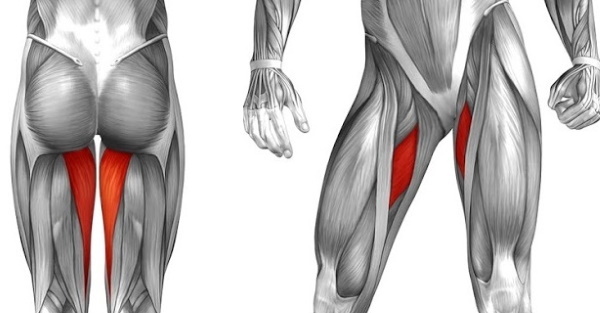
The group of adductors includes:
- short leading (adductor brevis) - a small muscle of the medial group;
- long leading (adductor longus) - resembling a triangle in shape;
- large leading (adductor magnus), the widest.
In addition to the squeezing muscles, the group includes 2 more muscles:
- Thigh muscle (Gracilis);
- a comb muscle resembling a quadrangle (Pectineus).
The anterior border of the adductor muscles is determined by the magnus adductor, which borders the medial vastus and the sartorius in front. At the posterior border, the adductor magnus cooperates with the posterior part of the semimembranosus muscle.
The comb, adductor longus and gracilis lie superficially, and the adductor short lies deeper than all. Gracilis also lies superficially in relation to the anterior part of the adductor maximus muscle.
All adductor muscles usually have parallel-oriented fibers that run from below, but not all of them have the same shape. The adductor maximus muscle, longus and short muscles have a common structure of the radial muscles. The thin one is in the shape of a belt, and the comb is flat in shape.
Functions and properties
The adductors of the thigh (the anatomy is presented on the site), as their name suggests, contribute to the adduction of the thigh to the hip joint.

All muscles to one degree or another participate in the internal rotation of the hip, its flexion and extension. The function of the gracilis muscle also includes flexion of the knee and rotation of the lower leg. The whole group is responsible for the stabilization and balance of the pelvis, affects the posture when standing, walking or running.
If the adductor muscles are weakened, then they create certain problems:
- posture is disturbed, expressed in pelvic instability, weakening of the press;
- "duck" gait develops;
- reduced muscle flexibility;
- there is a risk of developing injuries to the lower back, knees when playing sports.
Overstrain of the adductor muscles often leads to the development of trigger points in the groin and thigh. Tension at the junction of the long and short adductor muscles makes it difficult to move the knee joint.
In addition, adductor muscles often cause pain in the pubic, rectal, and bladder regions. Trigger points are activated during sports: skating, skiing, cycling.
Anatomy and structure
The adductor muscles of the thigh, due to their position, form the anatomy of the femoral surface in the medial space:
-
Long leading - This is a muscle located in front of the adductor group. It emanates from the anterior surface of the pubic body, then the fibers go down and to the sides to attach to the middle third of the aspera line (rough line of the longitudinal ridge of the femur). Its main function is adduction of the hip, and also assists in flexion of the extended and extension of the flexed hip.

The adductors of the thigh, they are all in the photo. - Short leading - It is triangular and the shortest of the adductor muscles. Its fibers originate from the lateral inferior ramus of the pubic bone and extend downward, laterally, and backward to attach to the top of the aspera line. Participates in hip flexion, depending on the position, rotates the femur laterally or medially,
- Large leading. The broad triangular muscle that forms the septum that separates the anterior muscles from the back of the thigh. In the medial section, it is the largest. It comes from the pubic bone, its lower part, from the branch of the ischium (anterior fibers) and the ischial tuberosity (posterior fibers). It is inserted into the tubercle medial to the gluteus, the middle of the aspera linea, the medial supracondylar line and the adductor tubercle of the medial condyle of the femur. Anterior fibers extending from the ramus of the pubis and ischium may contribute to flexion, while the posterior fibers radiating from the ischial tuberosity may contribute to stretching. Peak muscle contractions occur in hip flexion positions, such as full squats. The muscle is the main stabilizer of the pelvis. When walking and running, stabilize the hips and lower limbs to avoid excessive internal rotation.
- Thin muscle It is the most medial and superficial muscle of the medial thigh, overlying the other adductor muscles. The gracilis muscle originates from the inferior ischio-pubic ramus and pubic body, runs down the leg and attaches to the medial tibia. It is the only muscle in this group that crosses two joints: the hip and knee. Due to its attachment to the proximal part of the tibia, it is able to perform more functions than its neighboring muscles: it bends the knee, leads the hip and rotates it inward.
- Comb (musculus pectineus) is a short quadrangular muscle located in the supramedial part of the thigh. It extends from the pubis to a line between the lesser trochanter of the thigh and the upper part of the linea aspera. The main function is flexion and adduction of the hip in the hip joint.
Adductors of the thigh (the anatomy of the neural structures is described in detail in medical atlases) are innervated by the obturator nerve (L2-L4) and are supplied with blood mainly through the branches of the femoral and obturator arteries.
The main set of exercises
Any exercise in which the leg is pulled to the side will strengthen the adductor muscles. When training the adductors, the abductors will also be affected as they oppose each other.
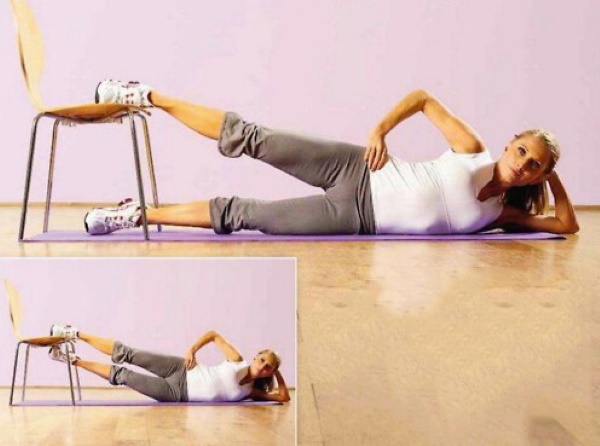
Before embarking on certain exercises, a warm-up should be carried out to increase the elasticity of the tissue, which significantly affects the reduction of the risk of injury. This is done to stretch the muscle fascia that covers all muscle tissue throughout the body.
Its purpose is to help protect and hold muscles in place. Muscle fascia often becomes tense or stiff for a number of reasons: too much specific activity or movement, insufficient stimulation of certain muscle groups, general overuse of muscle groups, or injury.
This leads to tightness, damage to the muscle fascia, and subsequent inflammation, the formation of trigger points. After training, you should take 12-15 minutes. stretching those muscles on which the emphasis was placed on busyness.
The adductor muscles of the thigh (the anatomy reveals the principle of operation of this group) can be prevented from injury, if stretching exercises that promote myofascial relaxation.
Scroll:
- Standing groin stretch. Place your feet wider than your shoulders - as far as comfortable, and then slightly bend your knees. Lean forward slowly with your hands on your hips. Bend the left knee a little further (the torso will also go in the same direction). When bending over, the right leg is straightened. Stay in this position for as long as possible. Then do this procedure with the other leg.
-
Sitting stretch. Sit on the mat with your knees bent and your feet flat on the floor. Clasp your legs with your hands and pull them towards you. Place your elbows between your knees and lean forward. Press your elbows down so that your legs move apart further. Hold the pose for 10-30 seconds.
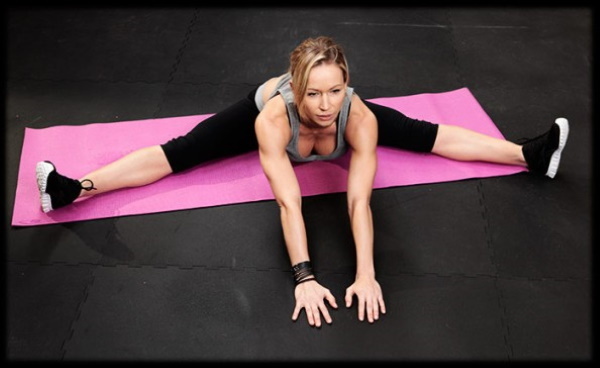
- Leading compression. Lie down, stretch your legs, placing foam or a roller between your thighs. Squeeze the hips, focusing on the tension of the internal muscles, for 5-10 seconds. Release and repeat the exercise 10 to 15 times.
- Stretching muscles with massage roll. Place the roll on the floor. Lie on your stomach with one leg bent at the hip joint. Place a roll under this leg, perpendicular to the thigh. Exercise slow pressure on the roll. In this case, the effect on the muscles and fascia of the adductor muscles should be felt. Instead of a roll, you can use a large massage ball.
What sets and reps in strength training mean:
- Repetition. Performing 1 cycle of exercises is repetition. If you perform the same movement 5 times in a row, that's 5 reps.
- An approach. Sets refer to sequential recruitment of a predetermined number of repetitions. If 5 reps are done in a row, then a short 1 minute break, then 5 more reps are done, this means 2 sets of 5 reps.
- Time relax between sets depends on the intensity, difficulty, and number of repetitions that are performed in a given set. For endurance training, it is recommended to rest for at least 30 seconds. up to a minute between sets.
Endurance training involves lifting light loads with high repetitions. Specifically, doing more than 15 reps per set will train muscle endurance. Performing high repetitions trains muscle fibers that are resistant to fatigue under stress.
Learning to do more reps with a specific weight, rather than lifting heavier weights in a smaller rep range, will be more beneficial.
Raising legs to the side
Exercise helps to strengthen the adductor muscle structures:
- Lie on your right side with your legs extended straight.
- Place a pillow under your head or support it with your right hand.
- Slowly raise your left leg until it stops.
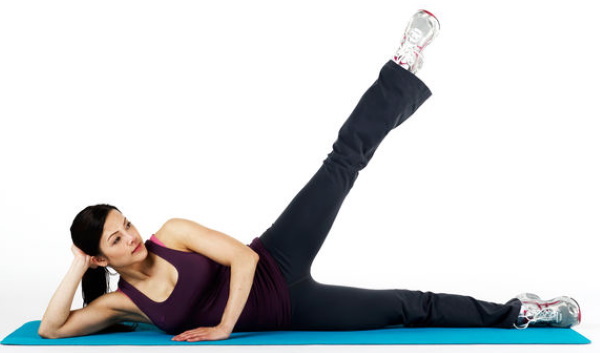
- Hold in this position for a few seconds before lowering the limb.
- Do 2-3 sets of 8-16 reps on each side.
Side lunges
Lateral lunges strengthen the calves, glutes, hamstrings, and inner thighs.
Exercises are performed without dumbbells, but to strengthen the pull, you can add them:
- Stand up, feet shoulder-width apart, arms with dumbbells down at your sides.
- Bending one knee, take a large step to the right with the other leg, while arms with dumbbells should be along the bent leg.
- Hold in this position for a few seconds, the back should be straight.
- Leaning on the buttocks and hamstrings, return to the starting position.
- Repeat alternating sides for 6-8 reps on each leg.
Wide leg squats
Exercises are aimed at strengthening the adductors, gluteal muscles and quadriceps:
- Stand straight with your legs wider than your hips.
- Slowly lower your hips down as far as possible.
- Pause by contracting the internal muscles.
- Return to starting position.

- Do 2-3 sets of 8-12 repetitions.
Ball Exercise
The gym ball is suitable for strengthening the adductor muscles:
- Lie on the floor, knees bent, a ball is squeezed between them.
- Squeeze the ball, alternately tensing the muscles.
Step to the side on one leg with the ball
To maintain balance, you can lean against a wall:
- Stand up, straightening your spine, rest your hands on your sides.
- Extend one leg and put it on the fitball.
- While rolling the ball, slowly move your leg to the side.
- Repeat the exercise with the other leg.
Dumbbell Squat
The weighting exercise is aimed at strengthening the adductor muscles:
- Stand with your feet apart.
- Take dumbbells, Lower your hands along the body.
- While inhaling, looking forward, sit down.
- When the hips are in a horizontal position, return to the original position.
- Exhale the air when finished.
Dumbbell Lunge
- Spread your legs slightly, take dumbbells, lower your arms, straighten your back.
- When inhaling, make a wide lunge forward with your left leg, put your right leg on your knee, keep your torso straight.
- At the end of the movement, exhale the air.
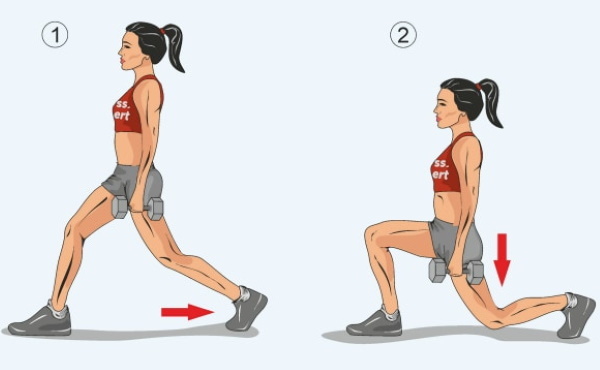
- Repeat everything with the other leg.
Exercise "butterfly"
Movement helps to stretch the adductor muscles:
- Sit on the floor, back straight, bend your knees, connect your feet, heel with heel, toe with toe.
- Grab your feet with your hands, gradually moving them closer to the pelvis.
- Tilt your back slightly forward and hold in this position.
- Try to lower your knees as much as possible.
- Hold the position for at least 3 minutes.
- Breathe evenly and deeply during exercise.
- For every 4 exhalation, try to press your knees even closer to the floor.
- Slowly connect your hips, relax.
Recurring scissors
Exercise helps to stretch the inner thigh muscles:
- Lie on your back, raise your legs and join them together. Stretch your arms, put your palms down.
- Raise your legs, cross them in the air.
- Spread your legs all the way.
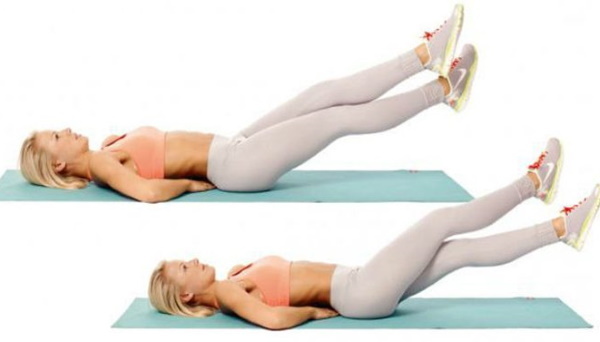
- Repeat the exercise, alternating the position of crossing the legs: first the right in front, then the left.
Shell on the side
- Lie on your left side, stretch the body.
- Bend your knees, bring your hips closer to the body, not reaching 80-90˚. Put your left hand on your elbow, resting your palm on your head. Right - put forward, palm should be in front of the stomach.
- Tear the feet connected together from the floor, while the left thigh does not come off the floor.
- In this position, the legs are spread and brought together at the knees.
- After 5-10 repetitions, turn on the other side and carry out the exercise.
Week schedule
Abductor and adductor resistance exercises can be done two or three times a week on non-sequential days.
Sample home workout program:
- warming up - 5-8 minutes, with a pulse of 120-150 beats / min;
- the exercises should have at least 4-5 approaches;
- each set has about 8 reps;
- rest between sets - at least 1 minute;
- the total volume of training is 20-25 approaches.
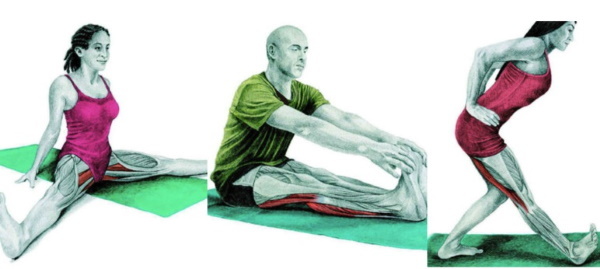
| Days of the week | Exercises |
| Monday | Raising legs to the side |
| Side lunges | |
| Step to the side on the same side with the ball | |
| Tuesday | Side lunges |
| Wide leg squats | |
| Dumbbell Lunge | |
| Wednesday | Rest |
| Thursday | Side lunges |
| Raising legs to the sides | |
| Spread-legged scissors | |
| Exercise "butterfly" | |
| Friday | Lifting the buttocks |
| Ball Exercise | |
| Dumbbell Squats | |
| Side Shell Exercise | |
| Saturday | Rest |
| Sunday | Rest |
After the feeling of hardened muscles arises, you can add another 1-2 sets.
When choosing exercises, you should pay attention to training not only the adductor muscles, but also the quadriceps, hamstrings, and muscle corset. Trainers do not recommend doing only a single muscle group, you need to train the whole body as a whole.
When to expect an effect
If workouts that strengthen muscle tone are carried out with a large number of repetitions, and the weight of the dumbbells is small, then the result can be seen in 2-3 weeks. Such training does not bring much muscle fatigue and pain. It is advisable to do exercises for other muscle groups the next day.

Then, with regular training, all muscles will be tense and ready to work, and constant tone will lead not only to strengthening muscle tissue, but also to weight loss. It should be remembered that the effect of tonic exercises on the adductor muscles of the thigh is short-term.
After canceling training, the muscles "deflate". Anatomically, the muscular structures of the thigh are deeply located and therefore many forget about them, being carried away by pumping the abdominal press, buttocks. If the internal muscles are not active enough and pumped up, then the target muscles will be weakly loaded.
Hip adductors video
Exercises for the adductors of the thigh:



